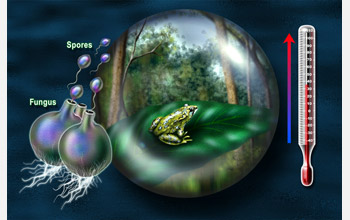Multimedia Gallery
Climate Change Driving Amphibian Extinction
Recent studies show the Earth's warming climate is contributing to the increase of chytrid disease, a fungus infection that is responsible for the extinction of many tropical frog species. The fungus, Batrachochytrium dendrobatidis, infects tadpoles and eventually attacks the skin of adults and kills them. Scientists know the spore stage can swim through water to infect other frogs, but there is still much to know about how the disease spreads, and if it can survive in other animals.
These results from a National Science Foundation-supported study provide the first clear proof that global warming is causing outbreaks of this infectious disease. The study demonstrates the complex nature of global climate change, including how climate affects the spread of disease, and why these must be integrated if we are to understand and reduce threats to species extinctions.
This image accompanied NSF press release, "Climate Change Drives Widespread Amphibian Extinctions."
Credit: Nicolle Rager Fuller, National Science Foundation
Images and other media in the National Science Foundation Multimedia Gallery are available for use in print and electronic material by NSF employees, members of the media, university staff, teachers and the general public. All media in the gallery are intended for personal, educational and nonprofit/non-commercial use only.
Images credited to the National Science Foundation, a federal agency, are in the public domain. The images were created by employees of the United States Government as part of their official duties or prepared by contractors as "works for hire" for NSF. You may freely use NSF-credited images and, at your discretion, credit NSF with a "Courtesy: National Science Foundation" notation.
Additional information about general usage can be found in Conditions.
Also Available:
Download the high-resolution JPG version of the image. (385 KB)
Use your mouse to right-click (Mac users may need to Ctrl-click) the link above and choose the option that will save the file or target to your computer.



